Artificial photosynthesis is a chemical process that biomimics the natural process of photosynthesis. The term artificial photosynthesis is used loosely, refer to any scheme for capturing and storing energy from sunlight by producing a fuel, specifically a solar fuel. An advantage of artificial photosynthesis is that the solar energy can be immediately converted and stored. By contrast, using photovoltaic cells, sunlight is converted into electricity and then converted again into chemical energy for storage, with some necessary losses of energy associated with the second conversion. The byproducts of these reactions are environmentally friendly. Artificially photosynthesized fuel would be a carbon-neutral source of energy, which could be used for transportation or homes. The economics of artificial photosynthesis are not competitive.

Gas mixtures can be effectively separated by synthetic membranes made from polymers such as polyamide or cellulose acetate, or from ceramic materials.
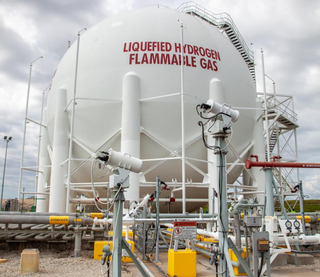
Several methods exist for storing hydrogen. These include mechanical approaches such as using high pressures and low temperatures, or employing chemical compounds that release H2 upon demand. While large amounts of hydrogen are produced by various industries, it is mostly consumed at the site of production, notably for the synthesis of ammonia. For many years hydrogen has been stored as compressed gas or cryogenic liquid, and transported as such in cylinders, tubes, and cryogenic tanks for use in industry or as propellant in space programs. Interest in using hydrogen for on-board storage of energy in zero-emissions vehicles is motivating the development of new methods of storage, more adapted to this new application. The overarching challenge is the very low boiling point of H2: it boils around 20.268 K (−252.882 °C or −423.188 °F). Achieving such low temperatures requires expending significant energy.

Metal–organic frameworks (MOFs) are a class of porous polymers consisting of metal clusters coordinated to organic ligands to form one-, two-, or three-dimensional structures. The organic ligands included are sometimes referred to as "struts" or "linkers", one example being 1,4-benzenedicarboxylic acid (BDC).

Omar M. Yaghi is the James and Neeltje Tretter Chair Professor of Chemistry at the University of California, Berkeley, an affiliate scientist at Lawrence Berkeley National Laboratory, the Founding Director of the Berkeley Global Science Institute, and an elected member of the US National Academy of Sciences as well as the German National Academy of Sciences Leopoldina.

An electrocatalyst is a catalyst that participates in electrochemical reactions. Electrocatalysts are a specific form of catalysts that function at electrode surfaces or, most commonly, may be the electrode surface itself. An electrocatalyst can be heterogeneous such as a platinized electrode. Homogeneous electrocatalysts, which are soluble, assist in transferring electrons between the electrode and reactants, and/or facilitate an intermediate chemical transformation described by an overall half reaction. Major challenges in electrocatalysts focus on fuel cells.
Covalent organic frameworks (COFs) are a class of porous polymers that form two- or three-dimensional structures through reactions between organic precursors resulting in strong, covalent bonds to afford porous, stable, and crystalline materials. COFs emerged as a field from the overarching domain of organic materials as researchers optimized both synthetic control and precursor selection. These improvements to coordination chemistry enabled non-porous and amorphous organic materials such as organic polymers to advance into the construction of porous, crystalline materials with rigid structures that granted exceptional material stability in a wide range of solvents and conditions. Through the development of reticular chemistry, precise synthetic control was achieved and resulted in ordered, nano-porous structures with highly preferential structural orientation and properties which could be synergistically enhanced and amplified. With judicious selection of COF secondary building units (SBUs), or precursors, the final structure could be predetermined, and modified with exceptional control enabling fine-tuning of emergent properties. This level of control facilitates the COF material to be designed, synthesized, and utilized in various applications, many times with metrics on scale or surpassing that of the current state-of-the-art approaches.

Solvothermal synthesis is a method of producing chemical compounds, in which a solvent containing reagents is put under high pressure and temperature in an autoclave. Many substances dissolve better in the same solvent in such conditions than at standard conditions, enabling reactions that would not otherwise occur and leading to new compounds or polymorphs. Solvothermal synthesis is very similar to the hydrothermal route; both are typically conducted in a stainless steel autoclave. The only difference being that the precursor solution is usually non-aqueous.

In crystallography, a periodic graph or crystal net is a three-dimensional periodic graph, i.e., a three-dimensional Euclidean graph whose vertices or nodes are points in three-dimensional Euclidean space, and whose edges are line segments connecting pairs of vertices, periodic in three linearly independent axial directions. There is usually an implicit assumption that the set of vertices are uniformly discrete, i.e., that there is a fixed minimum distance between any two vertices. The vertices may represent positions of atoms or complexes or clusters of atoms such as single-metal ions, molecular building blocks, or secondary building units, while each edge represents a chemical bond or a polymeric ligand.
Metal carbon dioxide complexes are coordination complexes that contain carbon dioxide ligands. Aside from the fundamental interest in the coordination chemistry of simple molecules, studies in this field are motivated by the possibility that transition metals might catalyze useful transformations of CO2. This research is relevant both to organic synthesis and to the production of "solar fuels" that would avoid the use of petroleum-based fuels.
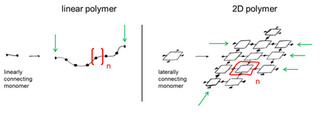
A two-dimensional polymer (2DP) is a sheet-like monomolecular macromolecule consisting of laterally connected repeat units with end groups along all edges. This recent definition of 2DP is based on Hermann Staudinger's polymer concept from the 1920s. According to this, covalent long chain molecules ("Makromoleküle") do exist and are composed of a sequence of linearly connected repeat units and end groups at both termini.

Imidazolate (C3H3N−
2) is the conjugate base of imidazole. It is a nucleophile and a strong base. The free anion has C2v symmetry. Imidazole has a pKa of 14.05, so the deprotonation of imidazole (C3H3N2H) requires a strong base.
Niveen M. Khashab is a Lebanese chemist and an associate Professor of chemical Sciences and engineering at King Abdullah University of Science and Technology in Saudi Arabia since 2009. She is a laureate of the 2017 L'Oréal-UNESCO Awards for Women in Science "for her contributions to innovative smart hybrid materials aimed at drug delivery and for developing new techniques to monitor intracellular antioxidant activity." She is also a fellow of the Royal Chemical Society, and a member of the American Chemical Society.
Some metal-organic frameworks (MOF) display large structural changes as a response to external stimuli, and such modifications of their structure can, in turn, lead to drastic changes in their physical and chemical properties. Such stimuli-responsive MOFs are generally referred to as a flexible metal-organic frameworks. They can also be called dynamic metal-organic framework, stimuli-responsive MOFs, multi-functional MOFs, or soft porous crystals.
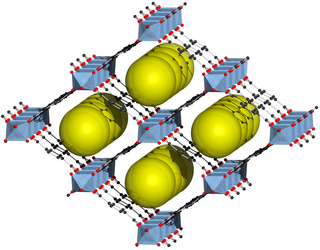
MIL-53 belongs to the class of metal-organic framework (MOF) materials. The first synthesis and the name was established by the group of Gérard Férey in 2002. The MIL-53 structure consists of inorganic [M-OH] chains, which are connected to four neighboring inorganic chains by therephthalate-based linker molecules. Each metal center is octahedrally coordinated by six oxygen atoms. Four of these oxygen atoms originate from four different carboxylate groups and the remaining two oxygen atoms belong to two different μ-OH moieties, which bridge neighboring metal centers. The resulting framework structure contains one-dimensional diamond-shaped pores. Many research group have investigated the flexibility of the MIL-53 structure. This flexible behavior, during which the pore cross-section changes reversibly, was termed 'breathing.effect' and describes the ability of the MIL-53 framework to respond to external stimuli.
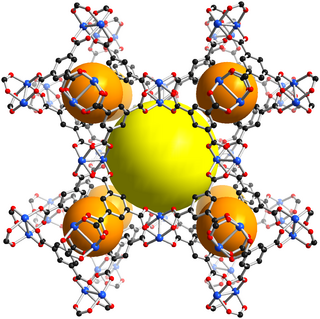
HKUST-1, which is also called MOF-199, is a material in the class of metal-organic frameworks (MOFs). Metal-organic frameworks are crystalline materials, in which metals are linked by ligands to form repeating coordination motives extending in three dimensions. The HKUST-1 framework is built up of dimeric metal units, which are connected by benzene-1,3,5-tricarboxylate linker molecules. The paddlewheel unit is the commonly used structural motif to describe the coordination environment of the metal centers and also called secondary building unit (SBU) of the HKUST-1 structure. The paddlewheel is built up of four benzene-1,3,5-tricarboxylate linkers molecules, which bridge two metal centers. One water molecules is coordinated to each of the two metal centers at the axial position of the paddlewheel unit in the hydrated state, which is usually found if the material is handled in air. After an activation process, these water molecules can be removed and the coordination site at the metal atoms is left unoccupied. This unoccupied coordination site is called coordinatively unsaturated site (CUS) and can be accessed by other molecules.
Tomislav Friščić holds the Leverhulme International Professorship and Chair in Green and Sustainable chemistry at the University of Birmingham. His research focus is at the interface of green chemistry and materials science, developing solvent-free chemistry and mechanochemistry for the cleaner, efficient synthesis of molecules and materials, including organic solids such as pharmaceutical cocrystals, coordination polymers and Metal-Organic Frameworks (MOFs), and a wide range of organic targets such as active pharmaceutical ingredients. He is a Fellow of the Royal Society of Chemistry (RSC), member of the College of New Scholars, Artists and Scientists of the Royal Society of Canada and a corresponding member of the Croatian Academy of Sciences and Arts. He has served on the Editorial Board of CrystEngComm, the Early Career Board of the ACS journal ACS Sustainable Chemistry & Engineering, and was an Associate Editor for the journal Molecular Crystals & Liquid Crystals as well as for the journal Synthesis. He was a Topic Editor and Social Media Editor, and is currently a member of the Editorial Advisory Board of the journal Crystal Growth & Design published by the American Chemical Society (ACS). He famously has a dog named Zizi.

Wendy Lee Queen is an American chemist and material scientist. Her research interest focus on development design and production of hybrid organic/inorganic materials at the intersection of chemistry, chemical engineering and material sciences. As of 2020 she is a tenure-track assistant professor at the École polytechnique fédérale de Lausanne (EPFL) in Switzerland, where she directs the Laboratory for Functional Inorganic Materials.
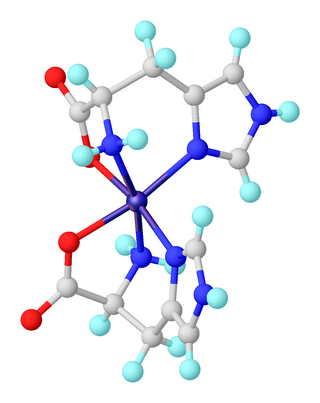
A transition metal imidazole complex is a coordination complex that has one or more imidazole ligands. Complexes of imidazole itself are of little practical importance. In contrast, imidazole derivatives, especially histidine, are pervasive ligands in biology where they bind metal cofactors.
Carboxylate–based metal–organic frameworks are metal–organic frameworks that are based on organic molecules comprising carboxylate functional groups.
















